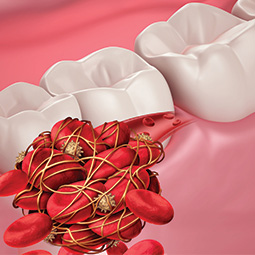About Platelet Rich Fibrin in Dentistry
Platelet rich fibrin treatment allows patients to quickly heal after surgery, and it encourages the regeneration of gum and bone tissue.
While dentists prefer the least invasive treatment of gum disease through nonsurgical treatment, that treatment approach has limitations, and in some cases, periodontal surgery is required to restore your health. In treatments where tissue or bone grafts are involved, the dentist can use platelet rich fibrin (PRF) to speed healing.
The following are three common dental surgical treatments where platelet rich fibrin assists in the patient’s recovery:
- Periodontal/gum disease treatment, including pocket reduction, regeneration or gingival flap surgery.
- Root canal treatment of the inner soft pulp of a tooth to remove bacterial infection.
- Implant surgery, the attachment of a metal anchor as a permanent base for either removable or permanent dentures.
How Platelet Rich Fibrin Helps Healing
Studies by the U.S. National Institutes of Health have shown that PRF:
- aids in bone regenerative surgery, especially in elderly patients
- encourages bone and soft tissue regeneration
- may be used alone or in combination with bone grafts
- promotes hemostasis — stopping the flow of blood
- has a low risk with consistently favorable results
The Role of Platelet Rich Fibrin in Periodontal Regeneration
Platelets stop the bleeding.
The platelet component of PRF is derived from a small sample the patient’s blood. Platelets are small and colorless. They are cell fragments of human blood and they form clots to stop or prevent bleeding. They derive from bone marrow, the gel-like substance in bones which contains stem cells that develop into red and white blood cells and platelets.
Platelets, then, are tiny blood cells that respond to signals when a blood vessel becomes damaged. The platelets rush to the site of damage and form the plug (clot) to repair the damage.
Fibrin is a protein which promotes clotting of the blood.
Our body produces fibrin, an insoluble protein, in response to bleeding. Fibrin is the major component of a blood clot and is a tough protein substance that is converted at the location of a wound when tissue damage results in bleeding.
Fibrin is a complex polymer involved in fibrinolysis, the body’s means of controlling clotting and preventing blood clots from becoming too large and causing other problems. Fibrin starts out as fibrinogen in the blood and arranges itself into strands — or polymerization — into what becomes a blood clot.
PRF is drawn from the patient from the vein into two sterile 6 ml (about 1/5 of an oz.) tubes. The technician uses a centrifugal machine at 3,000 rpm for 10 minutes. The result is a separation of the blood into its components, with the PRF settling in the middle of the tube.
Uses of PRF in Dental Surgery
Gum Recession Treatment
Gum (or gingival) recession treatment has become an important and common therapy. Dental surgery techniques now result in reliable patient treatment. However, after periodontal regenerative surgery, the goal is to promote the patient’s complete wound healing and tissue regeneration. The surgeon applies PRF membrane for root coverage on the surface of the tooth adjacent to the lips to speed healing after gum-flap surgery.
Root Canal Treatment
A root canal treatment has the goal of removing bacteria and infected tissue by filling, shaping and cleaning the root area. One cause of unsuccessful healing is when bacteria and infected tissue persist in the root space. When root canal treatment is unsuccessful, the final means to preserve the tooth is through apical — i.e., at the apex of the root — surgery.
Studies have shown that patients treated with PRF experienced less pain in the two to six hours following surgery. Swelling and edema — fluid in the tissue — never exceeded what was normally expected after any oral surgery.
Implant Surgery
Bone grafting or augmentation is an important element in successful dental implant surgery. For implants to work, they must be securely anchored. PRF is the biomaterial of choice for bone and soft tissue regeneration without inflammatory reactions. PRF can be used either alone or in combination with bone grafts to promote clotting, bone growth, and allow the bone to mature around the implant devices.
Coastal Periodontists at Lake Jackson Rely on PRF
Dr. Tredinick and the staff at Coastal Periodontics are qualified to perform dental implant surgery, gum recession treatment and surgical and nonsurgical gum disease treatment. Don’t wait for gum disease to take root and destroy your dental health. Contact us for an appointment or free evaluation.


